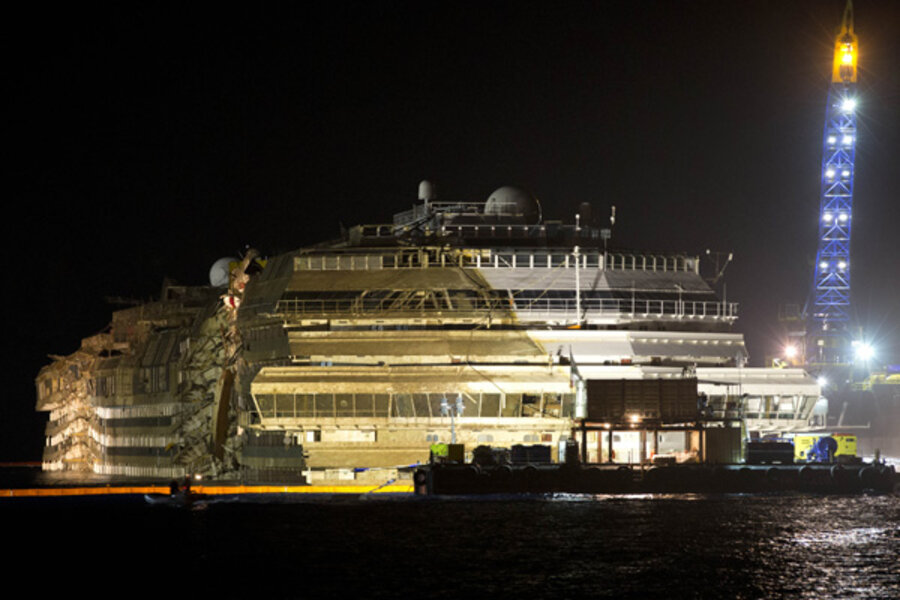Costa Concordia raised: 'The redemption of a nation bowed'
Loading...
| Giglio, Italy
Upbeat international teamwork was on full display off the Italian island of Giglio early this morning, after the successful raising of the Costa Concordia, the 3,700-passenger cruise ship that rammed into a nearby reef last January and collapsed onto its side.
The operation, which involved a complex system of steel cables, winches, and pylons, took 19 hours – nearly twice as long as originally predicted.
Engineers said the delay was due to the fact that it had taken more force than expected to prize the cruise liner from the rocky reefs on which it lay, as well as some minor technical problems involving the cables.
“It needed a bit more oomph than we had expected. The strand jacks [winches] had to go slower than we’d originally thought,” says Richard Habib, the head of Titan Salvage, the US firm that led the project.
The ship is an extraordinary sight – half of it is still pristine and white, glinting in the autumn sunshine, while the other half is smeared with brown slime and algae.
As the 950-ft.-long liner was finally hauled upright at 4 a.m. local time, salvage boats sounded their horns.
Jubilant salvage workers from more than 25 countries, including the United States, Italy, Britain, and The Netherlands, came into Giglio’s port and immediately headed to bars to celebrate.
“This is a once in a lifetime job,” says Denny Hoffschlag, a diver from the Netherlands. “There’s a lot of joy, seeing the ship finally upright. It’s an experience I’ll never forget.”
Nick Sloane, the South African salvage master who led the operation, was applauded by crews after coming ashore from a command-and-control barge that was anchored close to the wreck throughout the operation.
"It was a good challenge," he says. "Everyone is very pleased with how it went.”
With the help of video footage provided by five unmanned, remote-controlled submarines, he masterminded the effort along with the help of 10 colleagues on board the barge.
"We've nicknamed them the Magnificent Eleven," joked Franco Gabrielli, the head of Italy’s Civil Protection department and the official in overall charge of the project.
Italians hope that the successful recovery of the ship will help restore some degree of honor after the country’s international reputation was dragged through the mud by the alleged cowardice of the ship’s captain, Francesco Schettino, and the “bunga bunga” antics of Silvio Berlusconi, the former prime minister.
“The redemption of a nation bowed,” was the front page headline in Il Tirreno, an Italian newspaper, which said the country would no longer be held up as an international laughing stock. “They are a great people, the Italians. The problem is their commanders,” the paper said.
Even though the ship has been lifted upright, there is much work to do before it can be towed away from Giglio to an Italian port to be broken up for scrap. The salvage crews need to reinforce the starboard side of the hull, which suffered serious damage after crashing onto the island’s rocky shore.
There are two massive indentations in the hull, both to a depth of about 18 feet. Decks have been badly mangled, the hull stoved in and cabin windows smashed, their gaping holes framed by sodden, tattered curtains. It will take days to make the ship safe enough to be entered by Italian police and divers, who are under immense pressure to find the remains of two victims – an Italian woman who had been celebrating her 50th birthday and an Indian waiter.
Police are also keen to examine the shattered hull for possible evidence that could be used in the trial of Capt. Schettino. The authorities also want to recover 1,500 safes in the ship’s cabins, so that they can return valuables and other personal possessions to the passengers.
The ship is now resting on what engineers call an “artificial seabed” – six steel platforms that were constructed underwater. It is sitting much deeper in the water than normal, with only a third of its structure above the waves.
Costa Cruises, the Italian company that operated the ship, pledged to do whatever it takes to restore the seabed to its former state.
"This is a beautiful island with an intact environment and our commitment is to return it to the state that it was in,” says Michael Thamm, the CEO of Costa Cruises, the Italian company that operated the vessel. "We will deliver, you can rely on that.”
From a high cactus-strewn ridge overlooking the ship, it was possible to see a light slick of debris and a small quantity of dirty water draining out of the ship. But overall the fears of major pollution of the pristine coastal waters appear not to have been realized.
“Now that we can see the smashed up starboard side, it looks worse than it did before,” says Paolo, a middle-aged islander viewing the wreck from the rocky hillside. “The sooner they tow it away, the better.”
Schettino, who is on trial on charges of manslaughter and abandoning ship before all the passengers and crew were evacuated, is next expected to appear in court on Monday, in the city of Grosseto in Tuscany.








